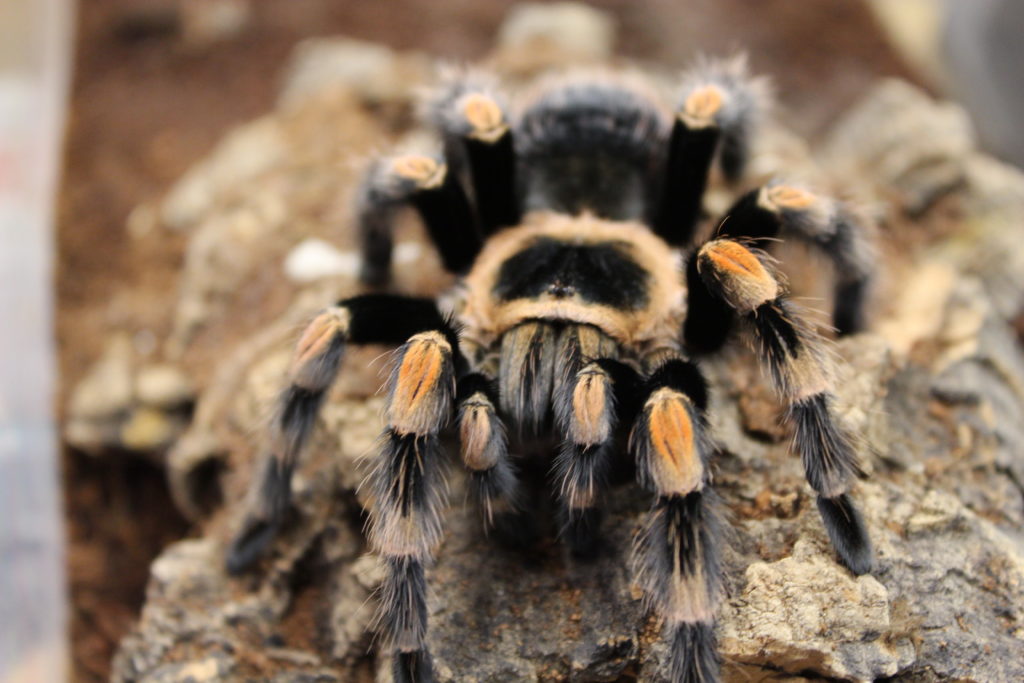Copyright 2021 Evolution Reptiles
All rights reserved.
Copyright 2024 Evolution Reptiles
All rights reserved.
All rights reserved.
If you say Tarantula to the average person, 99% of them will envisage the infamous Mexican Red Knee. It truly is an icon amongst both tarantula enthusiasts and casual keepers alike. This is mostly due to its ease of care and the strikingly beautiful orange colouration found on its knees (known as the patella).
In the wild, these long lived invertebrates can be found in Mexico, most commonly along the Central Pacific Coast. These regions tend to experience warm to hot (20ºC-32ºC) weather year round with a rainy season falling between June and October. This means that the Mexican Red Knee has evolved to survive in a variety of environments within which temperature and humidity fluctuates considerably. It is because of this that they have such a hardy nature and do so well within a captive environment.
These tarantulas grow to a good size with a leg span of up to 15cm, meaning they require a proportionally good sized enclosure throughout their lives. For an adult you are looking for an enclosure at least 45cm in length that allows for a decent depth of substrate- we would recommend a minimum of around 2-3 inches or more where possible. Glass or acrylic enclosures are often more favourable than wooden as they cope better with any damp or humid areas. To accompany this we suggest the use of a heat source; heat mats attached to the outside wall on one side tend to be the easiest and most efficient method of heating. Heat mats with a high wattage (above 10w) should always be used with a suitable thermostat in order to prevent overheating. We have found that keeping these animals with both a temperature and humidity gradient suits them best as they are able to choose the exact right conditions within the enclosure. Normally we will aim for a warm, dry end that sits between 28ºC and 30ºC as well as a cooler, more humid end of no less than 20ºC. Ventilation is also something to consider, with cross ventilation being very important, especially for the wellbeing of younger spiders. There should also be somewhere for the spider to hide away and feel secure, we recommend having at least 1, but 2 hides in different zones of the enclosure can be beneficial and help to reduce stress. A small, shallow water bowl in the cool end is recommended- particularly for specimens that are sub adult or larger.
Spiders in general are known for being low maintenance and this species is no exception. We’d recommend checking them at least 2-3 times per week, refilling their water bowl when you do so and dampening substrate in the humid end when it starts to dry out. This can be done either by lightly spraying or pouring a small amount of water directly onto it. Feeding this species is very straightforward as they have a voracious appetite. We recommend feeding them 1-2 times per week with a suitably sized meal. This will most often be in the form of a cricket, locust or cockroach; with worms being used as an occasional treat.

Many believed the two common species of red knee available in the hobby were B. smithi and B. annitha (the normal and giant forms). These names have since been re-evaluated with the smaller, more commonly available form now being known as B. hamorii and the giant form taking on the name B. smithi. These two species differ in size but they also differ very slightly in colouration and pattern. The patella (knees) of the hamorii often have small, black vertical lines within the vivid orange area, whereas this isn’t a commonly seen trait within true B. smithi specimens.
In terms of temperament there are only a handful of tarantulas that I would consider to be more docile than the Mexican Red Knee. While we never recommend handling any species of tarantula, this particular spider is incredibly easy to work with in comparison to many others. Like many new world species; they do have the ability to flick urticating hairs from their abdomen. They do this using their back legs but will only do so if they feel threatened. These hairs can cause irritation but the effects are very mild and can be avoided easily by working with the spider in a non threatening manner whenever possible. They are more often than not found to be gentle giants and would always be near the top of my list of nice natured tarantulas.
If you would like to learn more about Mexican Red Knee Tarantulas why not visit our shop or email us at info@evolutionreptiles.co.uk
Common name: Mexican Red Knee Tarantula
Scientific Name: Brachypelma hamorii
Location: Mexico (Central Pacific Coast)
Habitat (wild): Scrubland, Deserts, Tropical Deciduous Forests
Captive environment: Semi Arid, Terrestrial
Preferred temperature range: 20ºC to 32ºC
Humidity: 55-65%
Ferguson Zone: Unknown
UVB: Not currently thought to be necessary
Substrate: Coir fibre mixed with sphagnum moss, leaf litter
Lifespan: Females – 25 to 30 years/ Males- 7 to 10 years
Copyright 2021 Evolution Reptiles
All rights reserved.